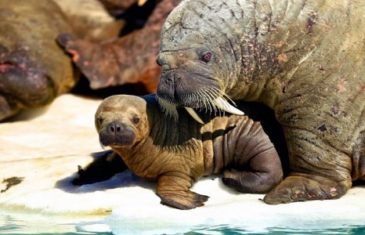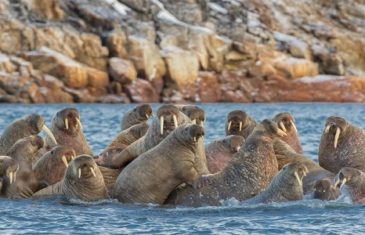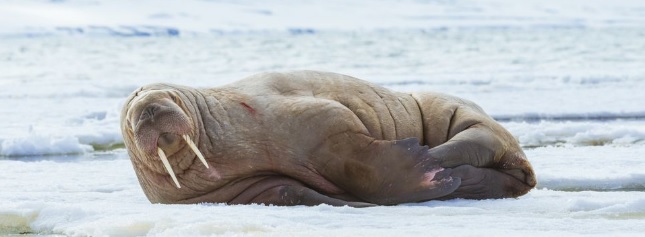

0
Conservation Status
- Walruses have been part of the culture of many indigenous Arctic cultures for thousands of years. They have hunted them for their meat, skin, blubber, tusks and bones. During the 19th and early 20th century its population was rapidly depleted. The Pacific species has rebounded since then but the Atlantic and Laptev species remain fragmented and have not recovered.
- The global status of the walrus as a species according to the IUCN Red List of Threatened Species is “Vulnerable”. However each subspecies have its own conservation status.
- The Atlantic walrus (Odobenus rosmarus rosmarus) is classified as “Near Threatened” by the IUCN.
- The Pacific subspecies (Odobenus rosmarus divergens) is classified as “Data Deficient”. Marine scientists have come to the conclusion after DNA testing that the Laptev walrus should be considered as part of the Pacific subspecies.
- Pacific and Atlantic walruses are protected from harvest in Russia, Norway. Canada, USA and Greenland. These countries have quotas reserved for subsistence harvest by aboriginal peoples.
- CITES lists walruses in Appendix III.
- The Bern Convention lists them under Appendix II.
- The highest impact in its population is global warming as sea ice declines.
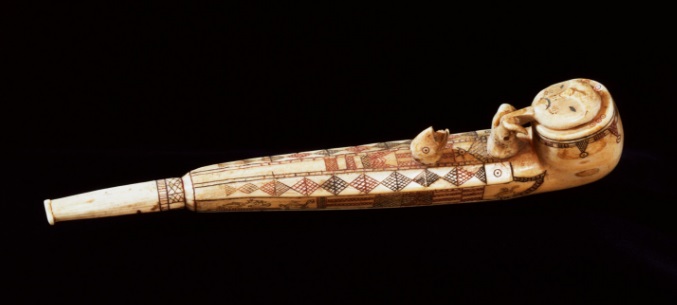
Inuit Ivory pipe carved from a walrus tusk. Photo: Smithsonian Magazine
Population and Distribution
- Walruses are found in the Arctic region with a discontinuous distribution around Arctic and subarctic areas. They are found in shallow continental shelf areas.
- The Atlantic walrus population is distributed from the eastern Canadian Arctic to the western Kara Sea in northern Siberia. Vagrants are found in New England, Iceland, Norway and Bay of Biscay in France and Spain. Its population is estimated to be 25,000 with a continuous decline in mature individuals.
- The Pacific population is distributed from the Laptev Sea in the west to the Beaufort Sea in the east. The Bering Sea is considered the center of its range crossing boundaries between USA and Russia. Its population is estimated at over 200,000. Vagrants are found in the North Pacific Ocean to Japan and Alaska. Its population has recovered from 1950 when it was considered depleted to a historically high level in the 1980s.
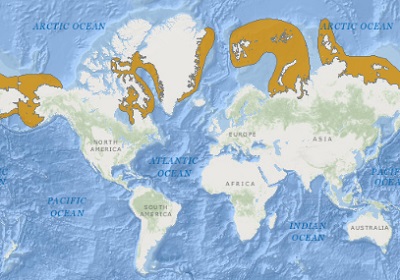
Walruses are distributed around the Arctic and Sub Arctic regions. Map adapted from IUCN.
Habitat
- Walruses live in coastal areas made up of ice platforms with access to shallow water up to 262 feet or 80 meters deep. They prefer areas of open water where they can find food.
- They spend two thirds of their lives in water when they surface they rest on ice floes.
- This marine mammal migrates north during the summer and south during winter.
- During summer months adult males inhabit coastal beaches while females and their calves stay on ice platforms.
- Walruses are very particular about their habitat and food. Global warming may lead to changes in their habitat such as receding ice floor and availability of food.
Physical description
- Walruses are pinnipeds, marine mammals that have front and rear flippers. This group includes sea lions, seals and walruses.
- The walrus’s most distinctive feature is its tusks which are elongated canines.They can grow to 3 ft 3 in (1 m) long and weight up to 12 lb (5.4 kl). Males have slightly longer and thicker tusks than females and are used to display dominance.
- Walruses have whiskers also known as vibrissae which are attached to muscles irrigated with a good supply of blood making them very sensitive organs.They use their whiskers to differentiate shapes, identify food and feel the ocean floor.
- Their skin is wrinkled and thick, it can be 4 in (10 cm) thick in the neck and shoulders. Adults have sparse hair that can be cinnamon in color or might appear pink under the sun or white after spending time under the water. Newborns have grey silver hair.
- They store large amounts of blubber under their skin which keeps them warm and functions as a storage of energy. Blubber can be up to 5.9 in (15 cm) thick.
- Pacific walruses are the largest and heaviest of the two subspecies. Males can reach 11.8 feet (3.6 meters) in length and weight from 1,940 to 3,433 lb (880 to 1,557 kg). Females are 9.8 feet (3 m) long and 1,280 to 2,290 lb (580 to 1,039 kg).
- Male Atlantic walruses weight an average of 1,984 lb (900 kg) while females 1,235 lb (560 kg). Males are 10 feet (3.1 meters) long and females 9.1 feet (2.8 meters).
Behavior
- Walruses congregate in groups of thousands to migrate south in the winter months and north in the summer as the ice floor recedes and expands. They can cover distances of 1,850 miles (3,000 km).
- Walruses are very social animals and are usually found in large tight groups of the same sex whether on land or at sea. Unless is mating season, males and females spend their time far apart. Females are usually found with their calves.
- They use floating sea ice for resting, birthing and nursing calves as well as for transportation to new feeding areas.
- They are vocal mammals. They communicate during mating season and between mother and calf.
- They have a hierarchical social structure based on age, size and tusk length. The strongest ones have access to females.
- Walruses perform shallow short dives to find their food. They rely on their whiskers to sense prey.
- Mother and calf on an ice float
- Males congregate together as they migrate
Diet
- Walruses eat small invertebrates including clams, worms, snails, crabs, shrimp and sea cucumbers. Some walruses prey on birds and other marine mammals such as seals.
Reproduction
- Mating season is from January to March. Walruses have a polygynous mating system, meaning that one male will mate with many females. They mate every 2 to 3 years.
- Males establish their own territories at sea where they make bell whistling noises to get the attention of females. Mating occurs in the water.
- Tusk fights are common among males. The strongest and oldest will mate with a group of females.
- Females reach sexual maturity at age 5 to 7. Males at age 7 to 10 but do not mate until they are socially mature at around 15 years old.
- Gestation lasts 15 to 16 months. Calves are born in the spring and mothers nurse them for over a year. They become independent at 3 years.
Life Expectancy
- In the wild walruses are expected to live from 30 to 40 years.
- In captivity they live up to 30 years.
Threats
- Global warming affects the availability of ice and food supply.
- Pollution and disturbance from oil and gas exploration.
Predators
- Killer whales (orcas) and polar bears and humans. Young walruses are more susceptible to predation.
Taxonomy
- Kingdom: Animalia
- Phyllum: Chodata
- Class: Mammalia
- Order: Carnivora
- Family: Odobenidae
- Genus: Odobenus
- Species Odobenus rosmarus
- Subspecies: Odobenus rosmarus rosmarus (Atlantic walrus)
- Subspecies: Odobenus rosmarus divergens (Pacific walrus)
- Subspecies: Odobenus rosmarus laptevi (Laptev walrus)
References and further research
- The Animal Aging and Longevity Database – Odobenus rosmarus
- IUCN Red List of Threatened Species – Odobenus rosmarus
- IUCN Red List of Threatened Species – Odobenus rosmarus rosmarus
- IUCN Red List of Threatened Species – Odobenus rosmarus divergens
- CITES Convention on International Trade in Endangered Species of Wild Fauna and Flora
- Convention on the Conservation of European Wildlife and Natural Habitats
- Itis Report – Odobenus rosmarus
- US Fish and Wildlife Service – Pacific Walrus
- COSEWIC Assessment and Update Status Report on the Atlantic Walrus (Odobenus rosmarus rosmarus) in Canada
- Food and Agriculture Organization of the United Nations – Fish and Aquaculture Department Odobenus rosmarus
- Norwegian Polar Institute Odobenus rosmarus
- Government of Canada – Species at Risk Public Registry Atlantic Walrus
